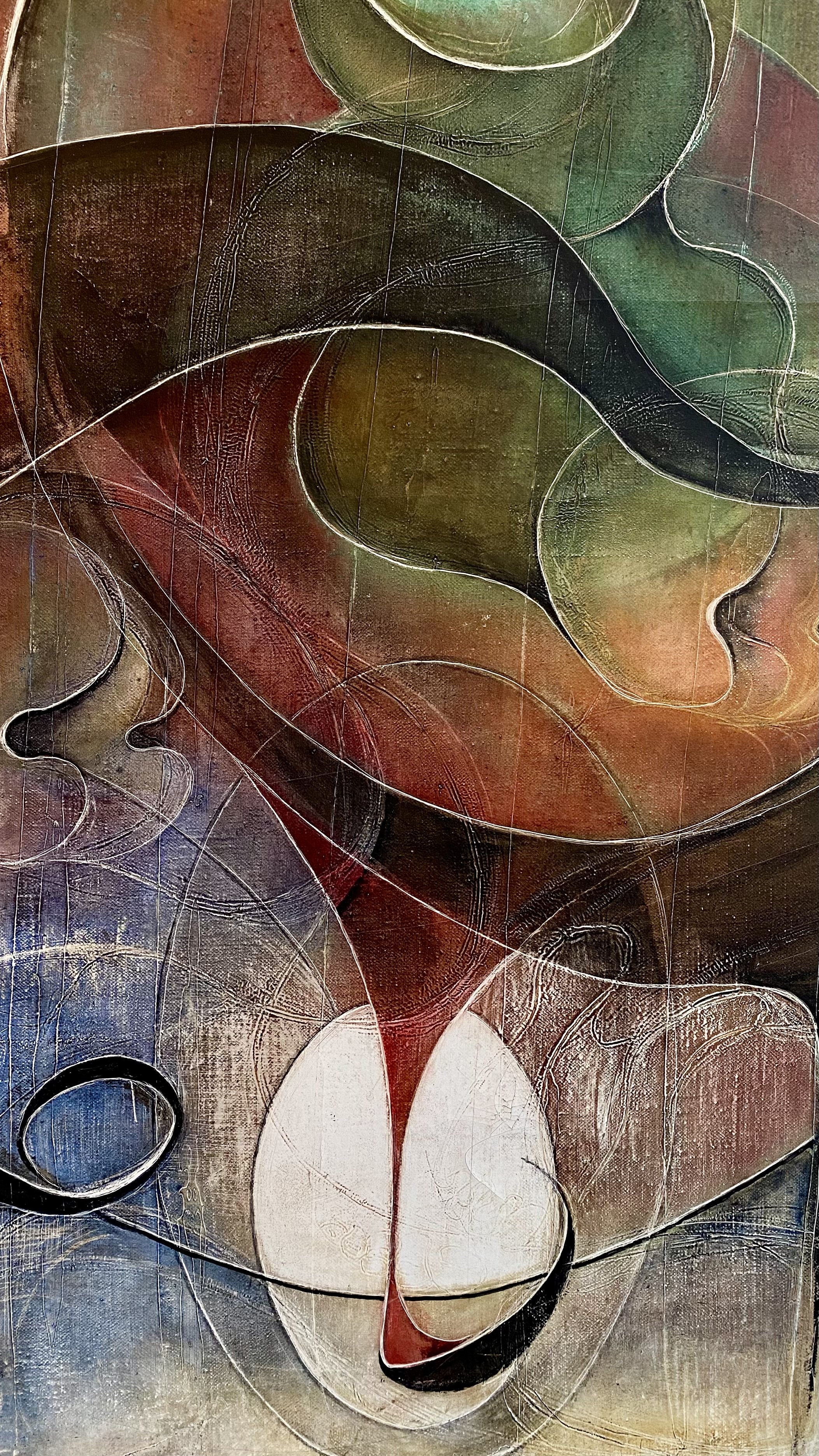
Jacqueline
Suzor
de Panafieu
At A.A. Knoop, 3 rare original paintings by Jacqueline Suzor de Panafieu are available for sale to collectors and connoisseurs—an opportunity to own a piece of 20th-century art history.
Immerse yourself in the world of Jacqueline Suzor de Panafieu (1903–1981), a French painter whose bold style evolved from precise animal portraits to emotionally rich abstract and fantastical works.
With over 600 paintings and drawings in her original archive, Suzor de Panafieu stands as a hidden gem in the landscape of modern French art.
3 Works by Jacqueline Suzor de Panafieu
From her second artistic beginning: the dawn of abstraction
Created between 1958 and 1959, these paintings mark the genesis of Jacqueline Suzor de Panafieu’s rebirth as an artist.
Having returned to painting after a long silence brought on by war, marriage, and motherhood, Pana, as she now signed her work, sought a radically new visual language—one that would give form to her inner states, rather than the visible world.
The pieces reflect her first technical experiments of this new era: ink washes, scratched lines, and the beginnings of what would become her signature use of layered, gestural abstraction.
Aquarel on Paper
Jacqueline Suzor de Panafieu (1959)
For Sale
Mixed Media on Canvas
Jacqueline Suzor de Panafieu (1958)
For Sale
Mixed Media on Canvas
Jacqueline Suzor de Panafieu (1959)
For Sale
A Rediscovered Voice of French Modern Art
Abstract painter. Symbolist. Pioneer among 20th-century French female artists.
Jacqueline Suzor de Panafieu was a visionary French artist whose dynamic career spanned figurative animal studies, lyrical abstraction, and spiritual symbolism. Today, her legacy is being rediscovered as a vital contribution to the history of modern art in France and the broader movement of women in abstraction.

Early Life and Education
Jacqueline Suzor de Panafieu was born into a privileged Parisian family, enjoying a childhood filled with education, travel, and sports. She was passionate about drawing from a young age, filling notebooks with sketches—often of elegant “garçonnes” and exotic oriental women.
At 16, she had a life-changing discovery: her godfather, Ambassador André de Panafieu, was actually her biological father. This revelation pushed her to live more independently, eventually joining him on diplomatic postings abroad, including in Poland.
Her father’s travels sparked a deep love for East Asian art, which gave her early work a refined precision and grace.
The 1920s-30s:
An Animal Painter and Mother
In the early 1920s, Jacqueline studied at the Académie Lhote, where she combined classical drawing techniques with cubist influences.
By the 1930s, she embraced the title of “animal painter,” creating vivid sanguine portraits and imaginative scenes featuring women alongside animals like Pekingese dogs, tigers, elephants, and panthers—all signed with her distinctive “JSP” monogram.
In 1933, she started exhibiting at the prestigious Salon de la Société Nationale des Beaux-Arts.
Her career paused after her marriage in 1935 and the birth of her children. Like many women of her time, domestic life temporarily silenced her public voice as an artist.

Return to Painting:
A Second Artistic Life
In 1957, after the war, her divorce and the death of her young son, Jacqueline returned to painting under a new name:
Pana.
Working late at night from her apartment studio in Paris—so as not to disturb her remaining children—she experimented with India ink, layering, scratching, and abstraction.
Her circle expanded to include Parisian intellectuals and avant-garde artists—Salvador Dalí, Alberto Giacometti, and more. This period marked a transformation toward emotional abstraction and gestural expression.
The 1970s: The Fantastic
And the Feminine
In the 1970s, her art evolved again—this time embracing the fantastic and symbolic. Recurring motifs such as eyes, hands, skulls, and mythological figures gave her work emotional and narrative depth.
She described this work as her “inner museum”, and her canvases became a mirror of internal worlds.
Themes of feminine power, pain, spiritual hunger, and cosmic connection emerged—placing her among the introspective and experimental of 20th-century women painters.
The Final Years: Spiritual Geometry and Transcendence
IIn her final phase (late 1970s–early 1980s), Panafieu’s paintings expressed a profound spiritual vision. Using geometric forms, cosmic symbols, and bold color fields, she aimed to elevate the viewer’s consciousness.
Triangles represented humanity; circles symbolized the cosmos. Her compositions, often structured with vertical “zips” inspired by Barnett Newman, explored the soul’s place in the universe.

Legacy and Recognition
Jacqueline Suzor de Panafieu died in 1981, leaving behind more than 600 works—spanning from delicate animal studies to powerful abstract expressions. She exhibited widely across France, Germany, Kuwait, and Canada, earning honors such as:
Grand Prix des Arts Décoratifs
Prix d’Excellence en Dessin
Médaille d'Or
She also served as vice-president of the Union of Women Painters and Sculptors (UFPS), advocating for female artists at a time when their contributions were often marginalized.
Noteworthy Expositions
Salon de la Société Nationale des Beaux-Arts, Grand Palais, Paris (1933, 1973, 1975, 1977, 1979)
Salon d’Automne, Grand Palais, Paris (1973, 1975, 1977, 1978, 1979)
Salon de l’Union des Femmes Peintres et Sculpteurs (UFPS), Musée du Luxembourg, Paris (1972–1980)
Salon des Artistes Français, Grand Palais, Paris (1973, 1980)
Festival de Wagner, Hôtel de ville de Bayreuth, Germany (1977)
Grand Salon de l’Association Française, Bilan de l’Art Contemporain, Québec, Canada (1981)
Aquarel on Paper
Jacqueline Suzor de Panafieu (1959)
For Sale
Mixed Media on Canvas
Jacqueline Suzor de Panafieu (1958)
For Sale
Mixed Media on Canvas
Jacqueline Suzor de Panafieu (1959)
For Sale
Interested in these works by
Jacqueline Suzor de Panafieu?
You can view and purchase her art in-store.
Visit A.A. Knoop Interiors in the centre of Amsterdam to explore and acquire pieces from our collection.



